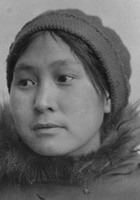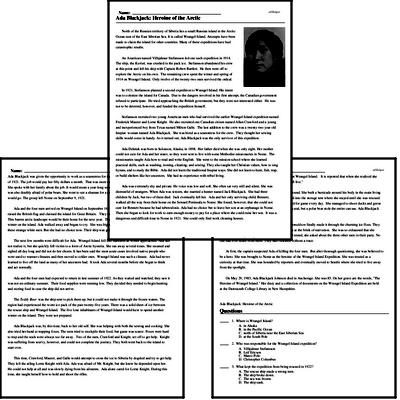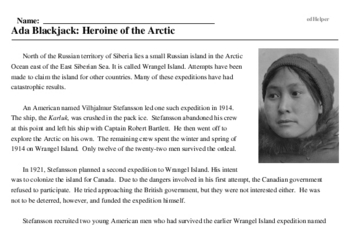Ada Blackjack: Heroine of the Arctic
North of the Russian territory of Siberia lies a small Russian island in the Arctic Ocean east of the East Siberian Sea. It is called Wrangel Island. Attempts have been made to claim the island for other countries. Many of these expeditions have had catastrophic results.
An American named Vilhjalmur Stefansson led one such expedition in 1914. The ship, the Karluk, was crushed in the pack ice. Stefansson abandoned his crew at this point and left his ship with Captain Robert Bartlett. He then went off to explore the Arctic on his own. The remaining crew spent the winter and spring of 1914 on Wrangel Island. Only twelve of the twenty-two men survived the ordeal.
In 1921, Stefansson planned a second expedition to Wrangel Island. His intent was to colonize the island for Canada. Due to the dangers involved in his first attempt, the Canadian government refused to participate. He tried approaching the British government, but they were not interested either. He was not to be deterred, however, and funded the expedition himself.
Stefansson recruited two young American men who had survived the earlier Wrangel Island expedition named Frederick Maurer and Lorne Knight. He also recruited one Canadian citizen named Allan Crawford and a young and inexperienced boy from Texas named Milton Galle. The last addition to the crew was a twenty-two year old Inupiat woman named Ada Blackjack. She was hired as a seamstress for the crew. They thought her sewing skills would come in handy. As it turned out, Ada Blackjack was the only survivor of this expedition.
Ada Delutuk was born in Solomon, Alaska, in 1898. Her father died when she was only eight. Her mother could not care for Ada and her sister, so they were sent to live with some Methodist missionaries in Nome. The missionaries taught Ada how to read and write English. She went to the mission school where she learned practical skills, such as washing, ironing, cleaning, and sewing. They also taught her Christian values, how to sing hymns, and to study the Bible. Ada did not learn the traditional Inupiat ways. She did not learn to hunt, fish, trap, or build shelters like her ancestors. She had no experience with tribal living.
Ada was extremely shy and private. He voice was low and soft. She often sat very still and silent. She was distrustful of strangers. When Ada was sixteen, she married a hunter named Jack Blackjack. She had three children by Jack, but two of them died. Jack eventually left her. Ada and her only surviving child, Bennett, walked all the way from their home on the Seward Peninsula to Nome. She found, however, that she could not care for Bennett because he had tuberculosis. Ada had no choice but to leave her son at an orphanage in Nome. Then she began to look for work to earn enough money to pay for a place where she could raise her son. It was a dangerous and difficult time in Nome in 1921. She could only find work cleaning houses.
Ada Blackjack was given the opportunity to work as a seamstress for the Wrangel Island Expedition in the spring of 1921. The job would pay her fifty dollars a month. That was more money than Ada had ever seen in her life. She spoke with her family about the job. It would mean a year-long separation from her beloved Bennett. Ada was also deathly afraid of polar bears. She went to see a shaman for a reading to help her decide. He told her she would go. The group left Nome on September 9, 1921.
Ada and the four men arrived on Wrangel Island on September 16, 1921. Even though it was not official, they raised the British flag and claimed the island for Great Britain. They unloaded all their supplies and set up tents. This barren arctic landscape would be their home for the next year. They were the first white men to spend a winter on the island. Ada walked away and began to cry. She was frightened. She did not want to stay here with these strange white men. But she had no choice now. Their ship was gone.
The next few months were difficult for Ada. Wrangel Island fell into darkness as winter approached. Ada did not realize it, but she quickly fell victim to a form of Arctic hysteria. She ran away several times. She moaned and sighed all day long and did not do her chores. It has been said the most acute cases involved native people who were used to warmer climates and then moved to colder ones. Wrangel Island was such a climate. Ada had never learned to live off the land as many of her ancestors had. It took Ada several months before she began to think and act normally.




